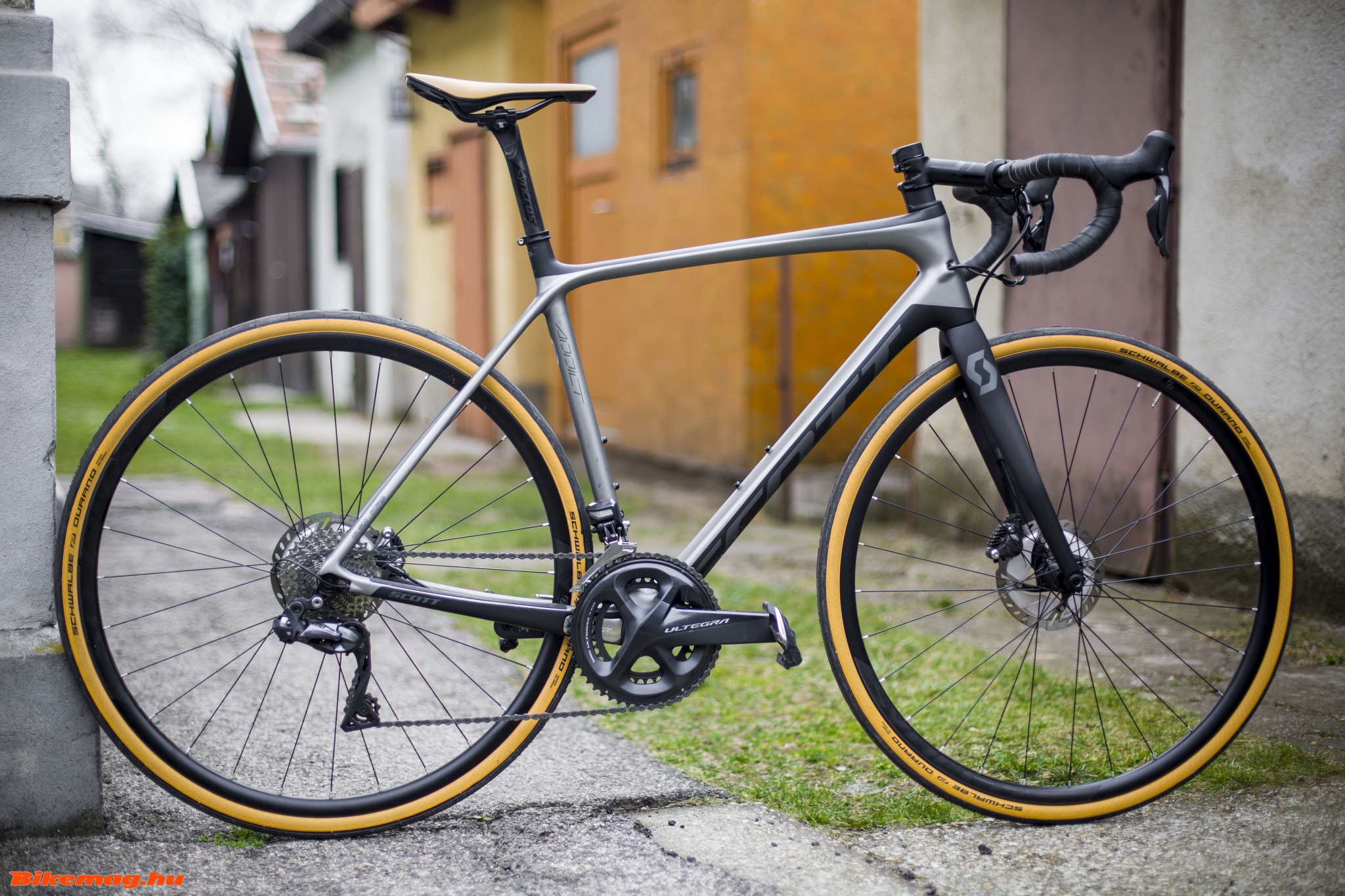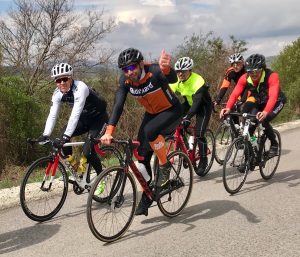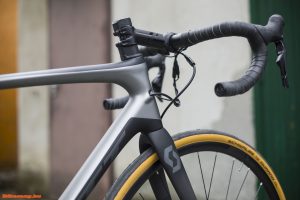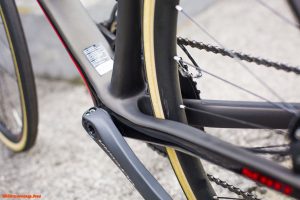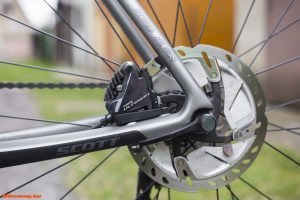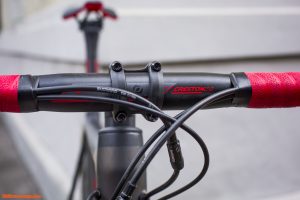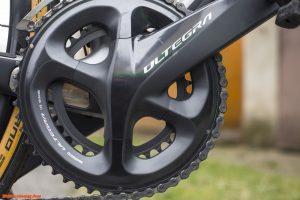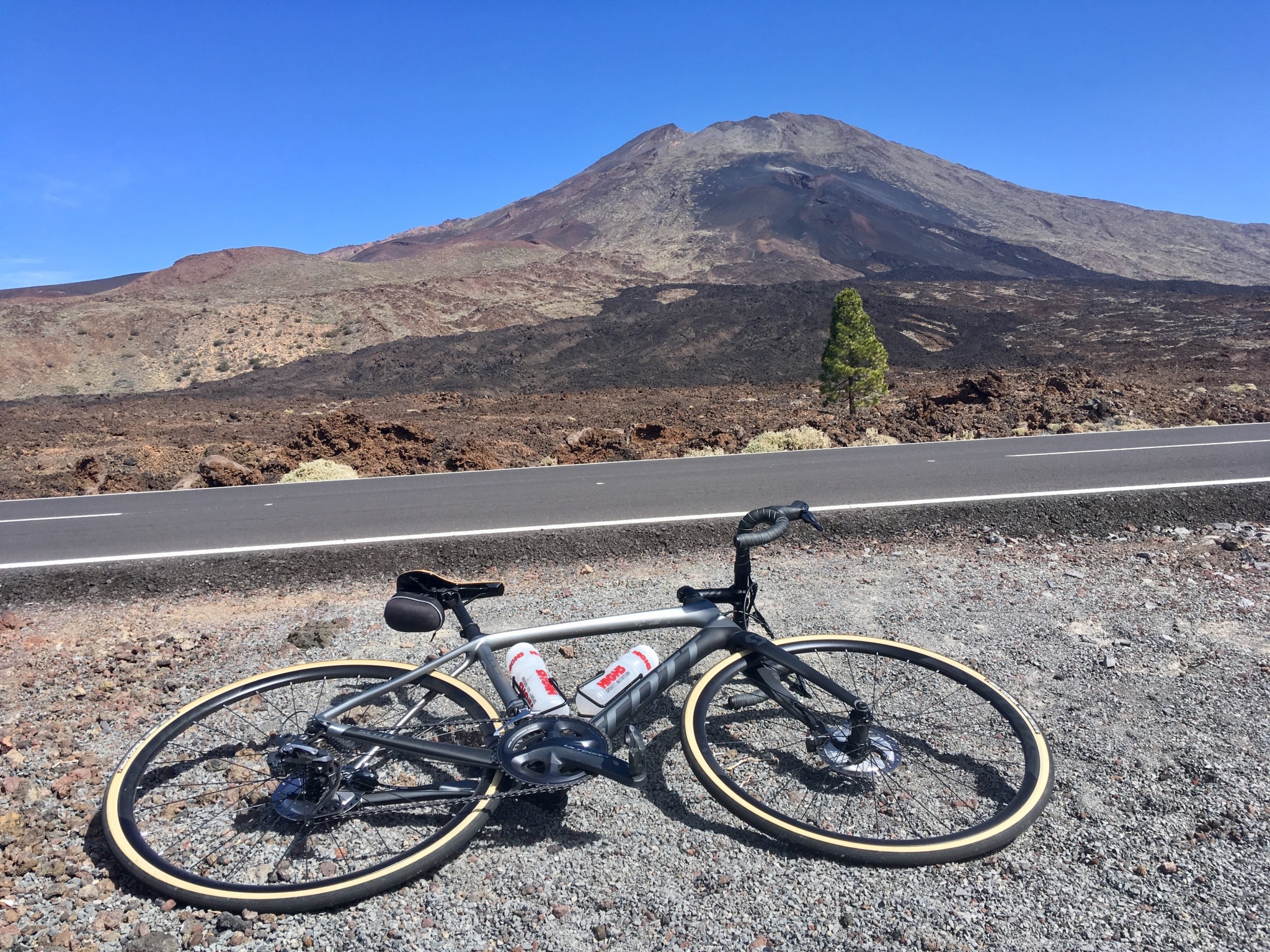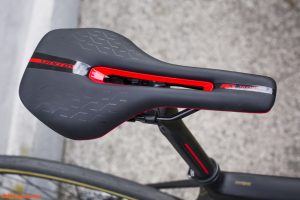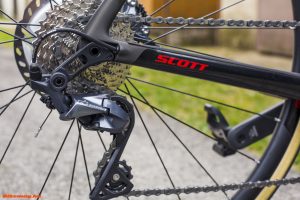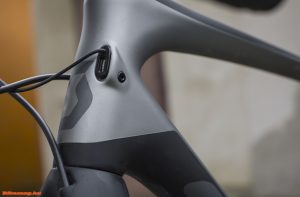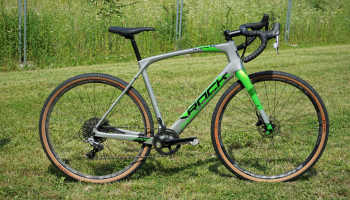The Scott Addict appears less often in the ads than the top-of-the-line Foil, nevertheless the model range offers a wide variety of choices to satisfy almost all the yearnings of a road cyclist.
The protagonists of this review are both Addicts, each with a distinct “flavor”. One offers a more comfortable frame geometry, the other has all but racing in mind. The former is called Addict SE (Special Edition) Disc and features a full Shimano Ultegra R8000 Di2 electronic component set, the “sporty” Addict RC 20 Disc is equipped with the mechanical version of this recent Ultegra “gruppo”. What is common for both, that they are designed to be ridden on pavement with modern hydraulic disc brakes.
Our first idea was to test both bikes in Di2 versions. Unfortunately the Addict RC 15 Disc we picked was sold out all over Europe. Scott bikes are indeed very popular, especially since the Swiss-American brand reduced the prices all across the range for 2019. There is already a waiting list for some Scott models, shipments for the afore-mentioned RC 15 Disc is promised for this summer. As we needed the bikes in March for our training camp in Tenerife, we had to settle for the mechanical version. At least we have a chance to compare electronic shifting to mechanical while reviewing the merits and the drawbacks of the two distinct Scott Addict frame geometries!
The Addict first appeared in 2006 as the flagship model in the Scott lineup. Then manufacturers were not required to put much emphasis on the aerodynamic properties of a road bike frame, rather they tended to concentrate on offering the lightest possible weight pair with stiffness that satisfied even professional riders. Such bikes could also be made quite comfortable to ride, which is always welcome. These days have long gone, and now the buzzword is “aero”. Henceforward Scott introduced the Foil range of road bike which is optimized primarily for aerodynamic properties. We should mention that Scott had offered excellent time trial and triathlon bike frames previously, so they were not stepping on unchartered territory with the trendy Foil series.
Many brands consider frame properties other than wind tunnel data more or less an afterthought. Most amateur riders rarely reach the speeds quoted for these aero tests, and would certainly welcome a little more comfort paired with some decrease in weight rather than harvesting an extra half watt in air drag reduction at neck breaking speeds. Last but not least, many tend to think that road bikes of a decade ago possess shapes that are as more pleasing for the eye. I consider the Addict to belong in this category.
The Scott Addict range includes bike models with both disc brake systems and traditional rim caliper versions. In fact, in the course of last year’s Giro d’Italia, race leader Simon Yates have been riding a rim brake Addict RC. He prefers this RC model to the disc variant, and the fine results put no question mark to his decision. All versions of the Addict demonstrate phenomenal engineering. The rim brake model weights 1100 gr for the complete frameset – that is including the forks! The disc version is a mere 60 gr heavier, making it one of the lightest road disc frameset on the market. To achieve such incredibly low mass, Scott employs very high modulus HMX carbon fiber material.
The RC variants of the Addict range offer a different frame geometry with virtually identical carbon manufacturing technology. Depending on the frame size, the head tube is 2-2.5 cm shorter compared to the non-RC Addict, while the horizontal top tube is approximately 5 mm longer. The seat tube angle is also a little shallower to lengthen the “cockpit”, providing more reach to the bars. Unless you have a very sharp eye for detail, you couldn’t tell the two types of Addict frames apart. All shapes and contours are the same, and there are no tell-tale signs that you’re riding one of the other version. Best of all, Scott is not putting much emphasis on the above-mentioned differences in their marketing material – they avoid extravagant making claims for the either the RC or the SE, allowing rider to remain completely satisfied with the Addict of choice.
The bikes in this review are both the disc brake versions for the given Addict frame variety. As it’s expected from a road bike featured in the World Tour peloton, both deliver ample of vertical compliance at the rear end without compromising stiffness of drive efficiency. Some may be bewildered when I say the added comfort is partly down to the disc-specific frame design. In fact the lack of a rear stay bridge to attach the rim brake caliper allows the rear to flex in the desired direction, while at the front it’s the added structural support of the thru-axle which lets designers to “play” with the suppleness of the fork blades.
All in all, the greatest advantage of the disc brake version for most riders lies not in the outright braking performance. Rather the added benefits the design represents the main draw. Personally I care very little about the additional power of discs since I modern rim brakes provide by far plenty. In case it rains, I rather sit in a café than to barrel down on nasty descents. So I wouldn’t buy a disc brake road bike based solely on the undeniably phenomenal stopping performance. But I still prefer a disc over the rim version for the added comfort, the stiffer front end, and the fact that I’m able to run a wider tire – in the case of both of these Addicts up to 32 mm size. Rim brake road bikes are generally limited to a 28 mm tire size by design.
The photos accompanying this review convey that both bikes offer pleasing lines. The finish is another matter. Matt paint is the rage at the moment, but unfortunately it has a tendency to exhibit even minor scuffs and marks. Similarly every stain from a drop of energy drink to a rain drop shows up on the surface, so it’s tough to keep the frame looking top-notch. Nonetheless, the matt metallic grey finish on the Addict SE Disc is stunning, everyone who saw it was completely astonished. The pictures in the printed brochure does no justice to this paintwork: it must be seen under natural light to be appreciated. The light creates a blaze that a photo cannot capture.
More or less the same is true for the brownish paint job of the RC 20 Disc. Not many would point at the catalogue photo saying “Yes, this is a fantastic finish!” On the other hand – once seen in flesh – it reveals a very pleasing brownish-grey hue, especially under direct sunlight. It’s truly a unique color tone that I for one couldn’t stop staring. Some remarked that the red graphics complementing the subdued greyish finish were a little overdone, and a black bar tape might have been a better match. Nevertheless the RC 20 is a generally pleasing design, which works well with the classic lines of the Addict frame.
I have done several hundred kilometers on both these bikes, and all I can say is that each one delivers what it promises. The SE has a much taller front end due to the longer head tube, raising the upper body with lesser bend over the handlebar. And we’re not talking about minute differences: for size M and L the head tube is full 25 mm longer! I would consider the front end of the SE to be overly tall, even for training rides, not alone full on racing. It’s perfectly suited to those who’re new to road riding, enjoy the swiftness offered by the narrow tires, the drop handlebars and the high-tech frame, but lack the flexibility to move into an aerodynamic body position. Thus making it ideal for club rides, light touring or someone just enjoying road cycling on a very fine piece of kit.
The RC’s front end is a striking contrast with its short, sporty 140 mm head tube (for size M). It was designed with pure racing in mind, placing the rider in an aerodynamic tuck, permitting full use of all the muscles. It’s for the experienced road rider looking for the outmost performance from the bike. Otherwise both Addict versions behave the same way: the handling is not too agile, but far from slow, spot on in the “goldilocks” zone for most road riding conditions.
It’s safe to say that both bikes offer something different for the particular rider, while keeping the basic concept the same – offering very a very high level of performance for each task on hand. No matter which model variant you choose, the Addict provides a harmonic ride experience, textbook handling and ideal stiffness to comfort ratio. All in all both are a joy to ride for the cyclist it was designed for. My “flavor” of Addict is clearly the RC, and I experiences no downsides to this bike at all. I have ridden the Scott Foil on many occasions, and compared to the present flagship model the Addict is plenty stiff, efficient, and – last but not least – it offers much better comfort on rougher road surfaces. Obviously the wider tires also play a role in the added suppleness, which could be run as low as 5-6 Bar without the fear of punctures. I actually went for a narrower 28 mm Vittoria Corsa at the test camp in Mallorca and enjoyed great comfort paired with excellent grip descending the island’s renowned hairpin roads.
These roads also proved to be ideal to test the disc brake systems on the bikes. Both feature the Shimano Ultegra units with 160 mm discs, which offer adequate cooling even on steep – over 10% gradient – roads with constant switchbacks. Heavier riders – especially those who tend to drag the brakes while descending – may experience some overheating under these conditions, and have to compensate for the fading effect, but most road cyclist will be totally fine using these excellent stoppers. Having timed my descents both this year in the previous training camp, I can attest that using the Ultegra hydraulic discs cut significant seconds off my previous record on board a top-notch bike with rim brakes!
The accessories – like handlebar, stem, seat post and saddle – are the identical on both bikes, carrying the Syncros brand. The bar and the stem are not overly distinguished pieces of kit, but they certainly match the design and the paint scheme, resulting in an aesthetically pleasing harmony. The stem looks especially good with spacers of corresponding shapes. These parts provide a stable platform, they do not show any flex, however the weight figures may not be something to write home about. The seat post is a carbon fiber construction, and the clamp mechanism was designed to provide some additional give to enhance suppleness. It’s a good match for the Addict’s comfort-oriented design concept.
The Syncros Tofino turned out to be a fine saddle: it fit me well and most who have ridden the bike. I have a similar saddle on my cyclocross bike, so I had high hopes for a pleasing relationship, and the Tofino didn’t disappoint. Of course this is a silly thing to say, but the saddle just looks comfy. My only excuse for this mindless comment is that this time the instinct turned out to be spot on. The Syncros RP 2.0 Disc wheelset is another good addition to both these bikes. They feature high-end DT Swiss hubs and tubeless compatible rims, and the weight doesn’t exclude the possibility of racing on these either: it’s roughly 1600 gr for the set.
The variance in frame geometry does not entail a surcharge, but the electronic group set does. The Addict SE carries a price tag that’s approximately 500 euro higher than for the race-oriented RC. (The former costs HUF 1,299,990 while the RC 20 sets you back 1,099,990.) I would say that for most riders the ease and speed of the gear changes may in fact compensate this extra expense. There is also the added convenience of not having to trim the front derailleur when shifting several sprockets at the back. On the other hand, those who are adverse of the modern technology on bikes, who prefer not to have to charge their shifting system or adjust the settings from a laptop still have the choice: the excellent mechanical Ultegra R8000 group set can be had on either of these bikes.
This was my first ride with the new R8000 version of the Japanese brand’s new second-tier Di2 set, and I was amazed by the simplicity and convenience of the new end of handlebar mounted control unit. It much more visible than the older stem-mounted device, the buttons are more accessible, you can do some fine adjustments and a possible system reset without taking the hands off the bar. Unfortunately I had to carry out the latter chore on several occasions during my rides, likely due to severe road bumps which seem to have set the rear derailleur to “protect” mode. It’s far from ideal, but at least the remedy was always – literally – on hand! Another upgrade to previous Di2 systems I have tried was the Synchronized Shifting and Semi-Synchro modes seen first on the Dura Ace, and now offered on the R8000.
Regarding the gear range the two bike differ slightly: the comfort-oriented SE offers 50/34T chairings paired with an 11-32T cogset at the back, while the RC has 52/36T in front and an 11-30T cluster on the hub. But proved to be sufficiently wide for the terrain we rode in Mallorca.
All in all I preferred the RC 20 over the SE, but as they say, it is horses for courses. Some will surely find the RC’s frame geometry overly aggressive, and will happily ride the more comfortable body position of the SE. This is possibly the best feature of the Scott Addict range: namely every type of rider is catered for, the high performance frameset is not reserved only for the seasoned riders. And if the Addict is not your cup of tea, there are other great model lineups ranging from outright aero to the rougher world of gravel and cyclocross. Whichever type of Scott bike you may settle for, you can expect the highest technological level paired with trendy modern design and a competitive price to boot. For more information click on the links below, which will direct you to the Hungarian distributor’s website. Alternatively just pop into the K2 Bike Shop in Budapest!

